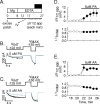HCN pacemaker channel activation is controlled by acidic lipids downstream of diacylglycerol kinase and phospholipase A2
- PMID: 17360902
- PMCID: PMC6672581
- DOI: 10.1523/JNEUROSCI.4376-06.2007
HCN pacemaker channel activation is controlled by acidic lipids downstream of diacylglycerol kinase and phospholipase A2
Abstract
Hyperpolarization-activated pacemaker currents (I(H)) contribute to the subthreshold properties of excitable cells and thereby influence behaviors such as synaptic integration and the appearance and frequency of intrinsic rhythmic activity. Accordingly, modulation of I(H) contributes to cellular plasticity. Although I(H) activation is regulated by a plethora of neurotransmitters, including some that act via phospholipase C (PLC), the only second messengers known to alter I(H) voltage dependence are cAMP, internal protons (H+(I)s), and phosphatidylinositol-4,5-phosphate. Here, we show that 4beta-phorbol-12-myristate-13-acetate (4betaPMA), a stereoselective C-1 diacylglycerol-binding site agonist, enhances voltage-dependent opening of wild-type and cAMP/H+(I)-uncoupled hyperpolarization-activated, cyclic nucleotide-regulated (HCN) channels, but does not alter gating of the plant hyperpolarization-activated channel, KAT1. Pharmacological analysis indicates that 4betaPMA exerts its effects on HCN gating via sequential activation of PKC and diacylglycerol kinase (DGK) coupled with upregulation of MAPK (mitogen-activated protein kinase) and phospholipase A2 (PLA2), but its action is independent of phosphoinositide kinase 3 (PI3K) and PI4K. Demonstration that both phosphatidic acid and arachidonic acid (AA) directly facilitate HCN gating suggests that these metabolites may serve as the messengers downstream of DGK and PLA2, respectively. 4BetaPMA-mediated suppression of the maximal HCN current likely arises from channel interaction with AA coupled with an enhanced membrane retrieval triggered by the same pathways that modulate channel gating. These results indicate that regulation of excitable cell behavior by neurotransmitter-mediated modulation of I(H) may be exerted via changes in three signaling lipids in addition to the allosteric actions of cAMP and H+(I)s.
Figures









Similar articles
-
Modulation of cyclic nucleotide-regulated HCN channels by PIP(2) and receptors coupled to phospholipase C.Pflugers Arch. 2007 Oct;455(1):125-45. doi: 10.1007/s00424-007-0295-2. Epub 2007 Jun 29. Pflugers Arch. 2007. PMID: 17605039
-
Neurophysiology of HCN channels: from cellular functions to multiple regulations.Prog Neurobiol. 2014 Jan;112:1-23. doi: 10.1016/j.pneurobio.2013.10.001. Epub 2013 Oct 29. Prog Neurobiol. 2014. PMID: 24184323 Review.
-
Properties of hyperpolarization-activated pacemaker current defined by coassembly of HCN1 and HCN2 subunits and basal modulation by cyclic nucleotide.J Gen Physiol. 2001 May;117(5):491-504. doi: 10.1085/jgp.117.5.491. J Gen Physiol. 2001. PMID: 11331358 Free PMC article.
-
Regulation of hyperpolarization-activated HCN channel gating and cAMP modulation due to interactions of COOH terminus and core transmembrane regions.J Gen Physiol. 2001 Sep;118(3):237-50. doi: 10.1085/jgp.118.3.237. J Gen Physiol. 2001. PMID: 11524455 Free PMC article.
-
Regulation of recombinant and native hyperpolarization-activated cation channels.Mol Neurobiol. 2004 Dec;30(3):279-305. doi: 10.1385/MN:30:3:279. Mol Neurobiol. 2004. PMID: 15655253 Review.
Cited by
-
Propofol inhibits HCN1 pacemaker channels by selective association with the closed states of the membrane embedded channel core.J Physiol. 2007 Aug 15;583(Pt 1):37-56. doi: 10.1113/jphysiol.2007.136465. Epub 2007 Jun 14. J Physiol. 2007. PMID: 17569731 Free PMC article.
-
Endocannabinoids Tune Intrinsic Excitability in O-LM Interneurons by Direct Modulation of Postsynaptic Kv7 Channels.J Neurosci. 2021 Nov 17;41(46):9521-9538. doi: 10.1523/JNEUROSCI.1279-21.2021. Epub 2021 Oct 7. J Neurosci. 2021. PMID: 34620719 Free PMC article.
-
GABA(B) receptor activation inhibits neuronal excitability and spatial learning in the entorhinal cortex by activating TREK-2 K+ channels.Neuron. 2009 Jul 30;63(2):230-43. doi: 10.1016/j.neuron.2009.06.022. Neuron. 2009. PMID: 19640481 Free PMC article.
-
General anesthesia mediated by effects on ion channels.World J Crit Care Med. 2012 Jun 4;1(3):80-93. doi: 10.5492/wjccm.v1.i3.80. eCollection 2012 Jun 4. World J Crit Care Med. 2012. PMID: 24701405 Free PMC article. Review.
-
The fast and slow ups and downs of HCN channel regulation.Channels (Austin). 2010 May-Jun;4(3):215-31. doi: 10.4161/chan.4.3.11630. Channels (Austin). 2010. PMID: 20305382 Free PMC article. Review.
References
-
- Anderson DH. Role of lipids in the MAPK signaling pathway. Prog Lipid Res. 2006;45:102–119. - PubMed
-
- Andresen BT, Rizzo MA, Shome K, Romero G. The role of phosphatidic acid in the regulation of the Ras/MEK/Erk signaling cascade. FEBS Lett. 2002;531:65–68. - PubMed
-
- Besana A, Robinson RB, Feinmark SJ. Lipids and two-pore domain K+ channels in excitable cells. Prostaglandins Other Lipid Mediat. 2005;77:103–110. - PubMed
-
- Bol GF, Gros C, Hulster A, Bosel A, Pfeuffer T. Phorbol ester-induced sensitisation of adenylyl cyclase type II is related to phosphorylation of threonine 1057. Biochem Biophys Res Commun. 1997;237:251–256. - PubMed
-
- Bollag WB, Zhong X, Dodd ME, Hardy DM, Zheng X, Allred WT. Phospholipase d signaling and extracellular signal-regulated kinase-1 and -2 phosphorylation (activation) are required for maximal phorbol ester-induced transglutaminase activity, a marker of keratinocyte differentiation. J Pharmacol Exp Ther. 2005;312:1223–1231. - PubMed
Publication types
MeSH terms
Substances
Grants and funding
LinkOut - more resources
Full Text Sources
